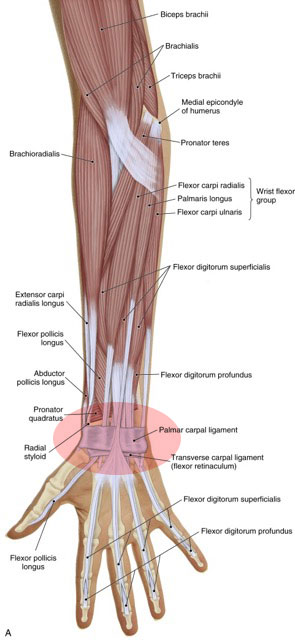Wrist Sprain / Strain / Tendinitis – Introduction

Sprains, strains, and tendinitis of the wrist can create pain anteriorly or posteriorly. Permission: Joseph E. Muscolino, The Muscle and Bone Palpation Manual (2016), Elsevier.
A wrist sprain is an overstretching or tearing of the ligaments and/or joint capsules of the wrist joint. A wrist strain is an overstretching or tearing of the musculature that crosses the wrist joint; tendinitis of the wrist is inflammation of the tendons of the musculature that crosses the wrist joint. Even though these are different conditions, they are often discussed together because they usually occur together and are similar in nature; in each case, soft tissue is irritated, overstretched, or torn. Strains and tendinitis especially occur together because they are both conditions of the muscle; strains are injury to the muscle belly; tendinitis is injury to the muscle’s tendon.
Causes
Wrist sprain, strain, and tendinitis also usually share the same causes. The two most common causes for these conditions are a macrotrauma or repetitive microtrauma. A typical macrotrauma is a fall on an outstretched hand. In whichever direction the hand forced, ligaments and tendons on the other side of the joint are injured, causing a sprain or tendinitis. If the fall is forceful enough, the stretching of the tendons may even pull and tear the associated muscle bellies, causing muscle strain. For example, if the hand is forced back into hyperextension, soft tissues on the anterior side of the wrist are injured; if the hand is forced into hyperflexion, the soft tissues on the posterior side of the wrist are injured.
Repetitive microtrauma may also cause sprains, strains, and tendinitis. Postures or motions that repeatedly place the hand into maximal end ranges of motion often result in sprain or tendinitis. Most common is placing the hand into extension, such as when doing push-ups with hands flat on the floor, or pushing against a heavy object with the palms of the hands. Overuse of the musculature that crosses the wrist joint, even in middle ranges of motion, often causes strain or tendinitis. For example, constant or repetitive activities that require gripping an object such as a screwdriver or hammer, or use of the hands and fingers, such as playing piano. Another common repeated microtrauma is placing pressure through the palms of the hands. This is especially prevalent for manual therapists, especially those who continually use their palms to generate deep pressure into their patients/clients.
Digital COMT
Did you know that Digital COMT (Digital Clinical Orthopedic Manual Therapy), Dr. Joe Muscolino’s continuing education video streaming subscription service for massage therapists (and all manual therapists) and movement professionals, has six folders with video lessons on Manual Therapy Treatment, including an entire folder on Stretching, as well as a folder on Pathomechanics, another on Anatomy, and many more? Digital COMT adds seven new video lessons each and every week. And nothing ever goes away! Click here for more information.
Signs and Symptoms
Wrist sprain, strain, and tendinitis usually cause weakness and pain locally in the wrist; and use of the hand increases the symptoms. The location of the pain is based on which tissues are injured. It is common for these conditions to affect the anterior side or the posterior side (although it is possible to injure just the ulnar side or the radial side soft tissues; this occurs less often).


